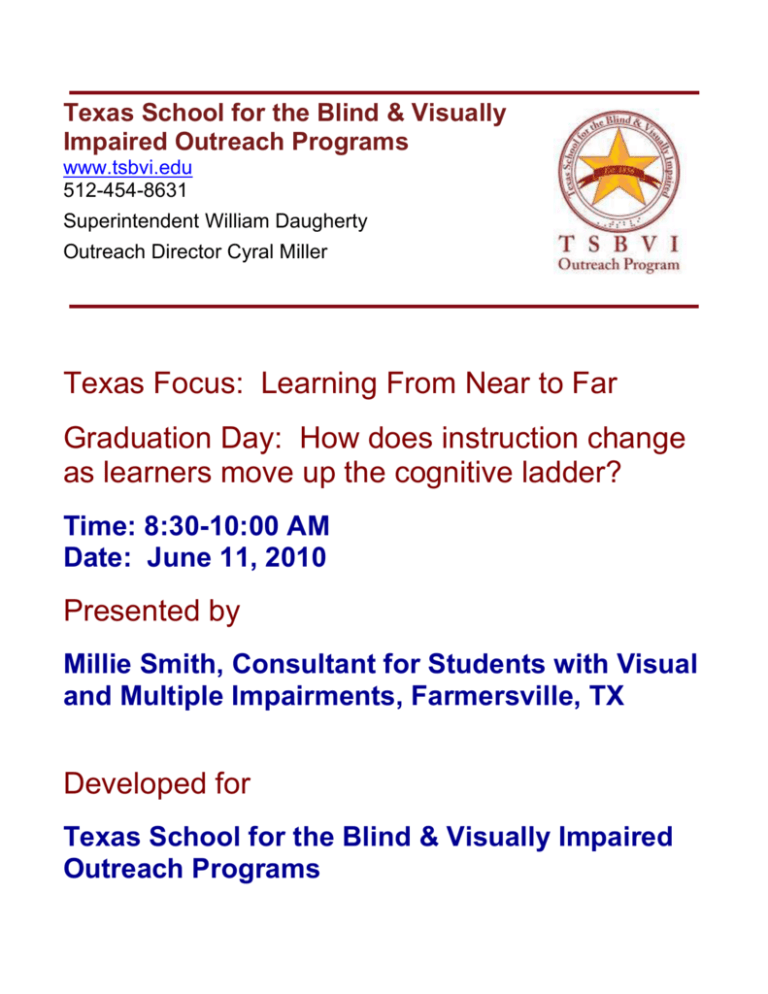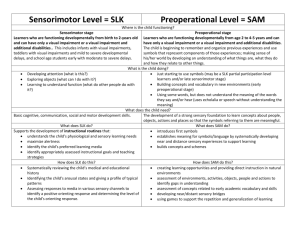SmithGraduationDayHandout - Texas School For The Blind And
advertisement

Texas School for the Blind & Visually Impaired Outreach Programs www.tsbvi.edu 512-454-8631 Superintendent William Daugherty Outreach Director Cyral Miller Texas Focus: Learning From Near to Far Graduation Day: How does instruction change as learners move up the cognitive ladder? Time: 8:30-10:00 AM Date: June 11, 2010 Presented by Millie Smith, Consultant for Students with Visual and Multiple Impairments, Farmersville, TX Developed for Texas School for the Blind & Visually Impaired Outreach Programs 2010 Texas Focus: Learning From Near To Far – M. Smith 1 Graduation Day How does instruction change as learners move up the cognitive ladder? Presented by Millie Smith Consultant for Students with Visual and Multiple Impairments COGNITIVE PERFORMANCE LEVELS Traditional-predictive Gifted Average Significantly sub-average o Mild o Moderate o Severe o Profound Developmental-behavioral/sequential o Sensorimotor o Preoperational o Concrete operational o Formal operational APH CONTINUUM- DEVELOPMENTAL MODEL Less stigmatizing Assumes progress is always achievable at any age Emphasizes characteristics of learning styles so that more appropriate instructional strategies can be provided 2010 Texas Focus: Learning From Near To Far – M. Smith 2 THE INTERVENTIONS Sensorimotor o The Sensory Learning Kit (SLK) Late sensorimotor, early preoperational o Symbols and Meaning (SAM) Late preoperational, concrete operational o Tactile Connections SENSORIMOTOR DEVELOPMENT (SLK) Random movements become intentional Actions are repeated to produce a desired consequence Desired objects not immediately seen or touched are searched for New strategies are used for obtaining desired outcomes LATE SENSORIMOTOR, EARLY PREOPERATIONAL DEVELOPMENT (SAM) Basic concepts emerge, but are based on the learner’s personal experience Concepts are one-dimensional and rigid Symbols with concrete referents are used to facilitate thinking about things in memory but not present Basic concepts are expanded through assimilation and accommodation 2010 Texas Focus: Learning From Near To Far – M. Smith 3 LATE PREOPERATIONAL, CONCRETE OPERATIONAL DEVELOPMENT (TACTILE CONNECTIONS) Objects can be classified according to multiple variables Concepts become less egocentric, thinking from another point of view is possible Categorical labels such as “person,” “animal,” “food,” etc. become available Symbols become more arbitrary and represent things that are more abstract SLK PROVIDES STRATEGIES AND ACTIVITIES FOR HELPING LEARNERS Pay attention to learning media with attractive sensory characteristics Explore high interest learning media presented in highly modified activities Use intentional behaviors to complete desired outcomes in familiar routines SAM PROVIDES STRATEGIES AND ACTIVITIES FOR Building concepts and schemes in natural environments Establishing meaning for symbols based on sensory experiences Introducing first symbols TACTILE CONNECTIONS PROVIDES STRATEGIES AND ACTIVITIES FOR Using part-object and arbitrary tactile symbols in augmentative communication systems Using part-object and arbitrary tactile symbols as a functional literacy medium 2010 Texas Focus: Learning From Near To Far – M. Smith 4 WHO USES SAM? Learners who are just starting to use symbols o Cognitively, about two to four years o Chronologically, about two years and up Learners who can say words, but do not understand the meaning of words said or heard WHAT FIRST SYMBOLS ARE INTRODUCED IN SAM? Single Words Objects presented in communication contexts Mimicked actions WHICH IS IT: NATURAL CONTEXT OR COMMUNICATION CONTEXT? Bath tub Fire station Calendar box Craft table Experience story Refrigerator Sam game HOW IS MEANING RELATED TO SYMBOLS? A symbol is meaningful if it calls to mind the thing to which it refers The symbol develops meaning by being paired with the actual thing to which it refers in here and now experiences 2010 Texas Focus: Learning From Near To Far – M. Smith 5 HOW DOES MEANING DEVELOP? A symbol is a label that opens a mental file Meaning is determined by the file contents These contents are called a “concept” Concepts are thoughts about things that develop over time as a result of direct experiences with people and objects in the environment Files organized into patterns get put into folders called “schemes” SAM CONCEPT CATEGORIES People: the self and others Objects: tangible things Actions: body movement of the self and others Places: where things are, contexts for groups of things HOW IS MEANING AFFECTED BY VISION LOSS? “delays in active exploration or variations in concrete experiences” result in o Absent and incomplete concepts o Objects experienced out of context and without intended function o Words without meaning o Concrete referents are missing 2010 Texas Focus: Learning From Near To Far – M. Smith 6 CONCRETE REFERENT An object, person, action, or place Given the symbol for it, the learner can touch it, point to it, do it, or go to it (direct sensory experience) CONNECT THE RELATED WORDS IN EACH COLUMN Concept Label Symbol Folder Scheme File CONNECT THE WORD AND ITS DEFINITION Symbol An organized pattern of knowledge about how things are related Concept Thoughts about a thing based on direct sensory experience Scheme Concrete referent The source of the direct sensory experience referred to by the symbol A word, object, or mimicked action that stands for a thing 2010 Texas Focus: Learning From Near To Far – M. Smith 7 LEARNING OPPORTUNITIES: THE GAME APPROACH Non-threatening and fun Abiding structure from context to context Maximize active learning Appropriate at any age Facilitate sibling and peer cooperative learning SAM CONCEPT LEVELS Concepts about the learner’s own body Concepts about people, objects, and actions touching the learner’s body Concepts about people, objects, actions, and places beyond the learner’s body Schemes about people-object-action-place relationships in events beyond the learner’s body SENSORY INFORMATION BUILDS CONCEPTS AND SCHEMES Near senses o Touch o Taste Distance senses o Vision o Hearing o Smell 2010 Texas Focus: Learning From Near To Far – M. Smith 8 INFORMATION GATHERED IS PRIMARILY NEAR OR DISTANCE? Learner’s own body People, objects, actions touching the learner’s body People, objects, actions, and places beyond the learner’s body People-object-action-place relationships in events beyond the learner’s body INFORMATION BTB AND IMPAIRED VISION Use to maximum extent possible Provide appropriate modifications o Acuity loss o Field loss o CVI Pair with touch experiences INFORMATION ABOUT THINGS BTB WITHOUT VISION Available distance senses: hearing and smell Hearing: environmental sounds and voices Problems with overdependence on auditory input o Hearing sounds gives no information about the source of the sound without associated touch (SAM CD) o Hearing voices helps learner recognize people and determine their location, but words used may not be meaningful 2010 Texas Focus: Learning From Near To Far – M. Smith 9 INFORMATION BTB WITHOUT VISION: BRIDGING STRATEGY Pair near and distance input Distance input used alone to bring to mind experience in which near and distance information was paired (Sensory bridging) Word and object symbols are helpful as bridges to distance information only if they are grounded in touch experience (Symbolic bridging) 2010 Texas Focus: Learning From Near To Far – M. Smith 10 Texas School for the Blind & Visually Impaired Outreach Programs 1100 West 45th Street Austin, Texas 78756 512-454-8631 www.tsbvi.edu Figure 1 TSBVI Outreach Programs logo Figure 2 OSEP logo This project is supported by the U.S. Department of Education, Office of Special Education Programs (OSEP). Opinions expressed herein are those of the authors and do not necessarily represent the position of the U.S. Department of Education. 2010 Texas Focus: Learning From Near To Far – M. Smith 11









